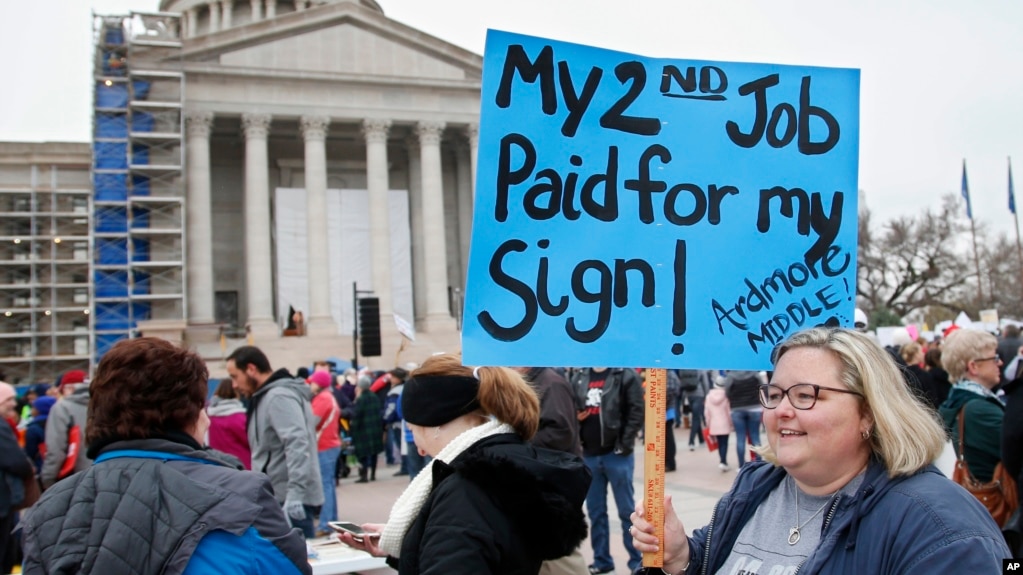Latest Breaking News
In reply to the discussion: Thousands of NC teachers marching through downtown Raleigh toward legislature [View all]appalachiablue
(41,103 posts)The article outlines basic teacher benefits, positives and important deficits.
------------
USA Today, "Do Teachers' Benefits Make Up for Lower Pay?" May 16, 2018.
Teachers are public employees and generally receive pension and insurance benefits (medical, dental, vision) that cover themselves and their families. But are these benefits overly generous? Do the benefits make up for lower pay?
"I wouldn’t necessarily say it’s generous, it’s way better than having nothing," said Tyson Gardin of Fort Mill, S.C., a physical education health teacher. "It’s not something I can complain about because there are people that don’t have anything." "You get a state plan but it comes out of your check, it’s not something that’s free," he added.
Recent teacher rallies and strikes in Arizona, Colorado, Kentucky, Oklahoma and West Virginia have put a spotlight on teacher pay and benefits.

These are some of the issues surrounding benefits and what teachers have to say about them:
*PENSIONS:
The vast majority of public school teachers are eligible for defined benefit plans where the state promises a guaranteed payout for life upon retirement based on length of service and earnings history. Generally, both the employer and employee make contributions and the state is responsible for investing the money to fund the pensions.
The traditional defined benefit pension can be quite generous for teachers who have put in many years of service since the payout grows larger with time.
But many state pension plans are underfunded and a push for pension reform has attempted to address this issue by modifying the plans. The modifications include lowering benefits for new hires, increasing employee contributions and reducing cost of living adjustments for retirees. "Pension costs have been shifted to the individual," said American Federation of Teachers president Randi Weingarten, as teachers are being required to increase contributions to their pension program.
A smaller number of states offer defined contribution plans, similar to 401(k)s, that do not guarantee a set payout. Instead, employers and employees contribute money to an account that the individual is responsible for investing to fund their retirement.
*SOCIAL SECURITY:
Complicating the retirement savings picture, about 40% of public school teachers, or more than 1 million, are not covered by Social Security, according to Bellwether Education Partners, a nonprofit education organization.
Social Security originally only covered private workers, but in the 1950s, Congress allowed states to extend coverage to its workers. Some states opted out of enrolling their workers and instead relied on pension plans with more generous payout formulas, according to TeacherPensions.org, a project of Bellwether Education Partners.
Most teachers in these 15 states and the District of Columbia do not pay into the Social Security system and do not receive benefits, TeacherPensions.org says: Alaska, California, Colorado, Connecticut, Georgia, Illinois, Kentucky, Louisiana, Maine, Massachusetts, Missouri, Nevada, Ohio, Rhode Island, and Texas.
Some teacher organizations argue that pension plans are not working for teachers and leave too many unprotected. TeacherPensions.org estimates "that half of all Americans who teach in public schools won’t qualify for even a minimal pension benefit, and less than one in five will remain long enough to earn a normal retirement benefit."
The study recommends enrolling all teachers into the Social Security system to provide a level of retirement protection that is portable.
*HEALTH INSURANCE:
The average monthly teacher employee contribution for family coverage health care rose from $334.40 in 2010 to $460.16 in 2016, according to the Bureau of Labor Statistics’ National Compensation Survey.
The portion of health insurance premiums public school teachers contribute has risen to 38%...
More, including teacher benefits compared with those of other professions....https://www.msn.com/en-us/news/other/do-teachers-benefits-make-up-for-lower-pay/ar-AAxmBFX?li=BBnbcA1
